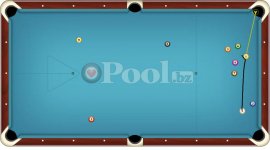What you say is very true. The friction (throw) that allows you to make a thicker hit on the object ball returns the favor and propels the cueball faster down the tangent line. Some days you just can't win.It's been awhile since I've played around with this. I always felt that the cue ball would throw in the opposite direction of the object ball and negate the purpose of hitting the shot full on. In other words, I thought that holding the cue ball from drifting with throw wasn't very effective.
However, there is a very modest reduction in the cueball's post-impact speed, which might be significant enough when the balls are close to each other, as Bob J. mentioned above. This is due to a reduction in the ghost ball angle. The ghost ball angle is defined by Dr. Dave as the angle formed by the line of centers of the CB and OB and the line of centers of the CB and GB. This angle is typically only a few degrees (or less), as compared to the cut angle, which of course can approach ninety-degees.
So, suppose you're facing a cut of 10 degrees but want to make up five of the 10 degrees with throw in order to limit cueball travel. You then aim for a 5-degree cut with an appropriate amount of outside english. If the balls are, say, 18" apart, the change in ghostball angle from the 10-degree cut to the 5-degree cut is only about 0.6 degrees - far less than the 5-degrees of effective cut angle reduction you were hoping for. (You do reduce the cut angle by 5 degrees, but the opposite throw of the cueball you cited, in effect, results in a reduction of cueball speed down the tangent line characterized only by the difference in ghostball angles.)
If the balls are much closer, 6" say, the change in ghostball angle is now about 1.8 degrees. This is still fairly small, but enough to be useful when you really need to put the brakes on.
Jim
Last edited:

